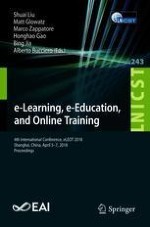2018 | Buch
e-Learning, e-Education, and Online Training
4th International Conference, eLEOT 2018, Shanghai, China, April 5–7, 2018, Proceedings
herausgegeben von: Shuai Liu, Matt Glowatz, Marco Zappatore, Honghao Gao, Bing Jia, Alberto Bucciero
Verlag: Springer International Publishing
Buchreihe : Lecture Notes of the Institute for Computer Sciences, Social Informatics and Telecommunications Engineering
